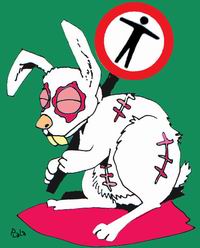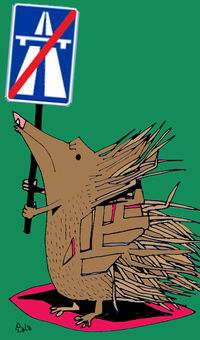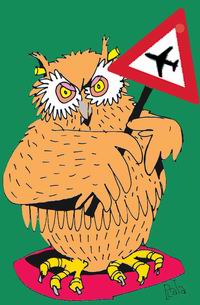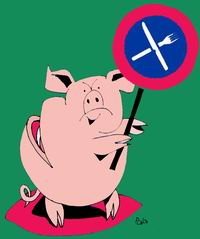What is the most fundamental principle underlying animal rights?
Is it respect, freedom, intrinsic value, love, compassion, equality, or another concept altogether? What should serve as the foundation for establishing animal rights?
While animals naturally assert themselves within their own habitats, this behavior alone does not equate to having rights. The concept of 'rights' is a construct conceived by humans, and it is only humans who employ it.
So why do we discuss animal rights?
The answer is straightforward: animal rights are intended to establish boundaries on human behavior. Without clear legal boundaries governing human conduct toward animals, there would be no basis for legal action against those who transgress these boundaries.
Animals are often defenseless, vulnerable, and entirely subject to human control. Individuals who disregard the well-being of animals should face legal consequences and be held accountable for violating animal rights. |
Subjects
What motivations for animal rights are relevant? |
| What is the basis for granting rights to animals? |
| Some concepts are unsuitable as a legal basis for animal rights. |
| Animal rights have the same basis for all animals but different implications. |
| Other concepts and summary. |
| Is it possible to conceive a satisfactory judicial basic principle that can be adequately employed? |
| If some people tend to violate the basic rights of animals, is freedom still employable as a fundamental right? |
See also (in a different article)
Isn't it a fact that possessing an animal actually contradicts the right of freedom? |
| Standing up for animal rights should be financially rewarded. |
| Should all wrongful actions towards animals be prohibited? |
People and animals relate to each other in different ways:
- animal lovers keep them as pets
- those who like the taste of
animals eat them
- some people believe their religion
demands them to sacrifice animals
- some people who like animals just leave them alone.
|
 The ways in which we relate to animals and the
rights we grant them has to do with ethics.
Albert Schweitzer stated that ethics should
be rooted in compassion. A right without
compassion cannot be implemented as a justifiable
action. How these issues interconnect will
be elaborated in this article. The ways in which we relate to animals and the
rights we grant them has to do with ethics.
Albert Schweitzer stated that ethics should
be rooted in compassion. A right without
compassion cannot be implemented as a justifiable
action. How these issues interconnect will
be elaborated in this article.
The concept of animal rights can be interpreted
in widely different ways. On the one hand,
some may exercise the right to kill animals
for the purpose of consumption or sports.
Some people, on the other hand, will deprive
themselves of the right to kill even the
smallest animal by mistake. |
What is the basis for granting rights to animals?
Topics
- Is there a satisfactory basic principle?
- Can freedom be maintained as a fundamental
right if it is infringed?
- Isn't being an owner of an animal in
conflict with the right of freedom?
- Advocating animal rights should be
financially rewarded.
- Should all wrongful actions towards
animals be prohibited?
 Animals are only capable of expressing
themselves indirectly in case of abuse.
Therefore it is up to us to answer the question above. Animals are only capable of expressing
themselves indirectly in case of abuse.
Therefore it is up to us to answer the question above.
Concepts that are eligible for forming the
basis of animal rights are intrinsic value,
welfare, respect, freedom, equality, compassion
etc..
Many of these concepts seem appropriate
but are less suitable if we apply them in
practical situations. |
We will now test the workability of each concept
according to a number of important principles.
- The formulation of animal rights should
be a workable and practical concept that
can be legally reviewed.
- Animal rights are meant to benefit
all individual animals including all species
from wildlife and agriculture e.g. domestic
animals, mammals, but also insects.
- Considering the diversity of those
species we should take into account their
specific nature.
- Animal rights apply to people and should
be called upon by people.
- Death holds a distinct position in
animal rights: the slaughter, hunting
by experts for the purpose of wildlife
management and professional fishing. Regulations
should be enforced to ensure a fast and
painless death, which must serve a purpose
(in contrast with undesired extra fish
to the catch). This also applies to killing
off harmful vertebrae, which can otherwise
not be stopped.
- Rights of the species outweigh the
rights of the individual (if a plant or
animal threatens to become extinct people
should be forbidden to disturb its life).
A certain species (e.g. sow or salmon)
has the right not to be produced or caught
in excessive numbers for export purposes.
This mass production is unworthy of an
animal and it is meant to satisfy more
than only our basic needs.
|
Some concepts are unsuitable as a legal basis for animal rights
On the basis of the first mentioned principle
we should exclude the concepts of intrinsic
value and respect. Though these concepts
are widely used, it is impossible to formulate
unequivocal animal rights on the strength
of either concept. It is perfectly acceptable
to mention intrinsic value and respect when talking about behavior towards animals
but the concepts cannot be used to judge
human behavior from a judicial point of
view.
"Madam, we intend to summon you
to appear in court for treating your lap
dog without respect". Of course it
is always possible to distance yourself
from objectionable behavior and to label
it as disrespectful behavior. An example
is when circus bears and lions are forced
to do tricks unworthy of an animal, you
may say that this is treating animals in
a disrespectful way.
Likewise you cannot enforce civilized behavior
or good taste but you can comment on these
matters.
The concept of intrinsic
value is also unsuitable as a legal
basis for animal rights. It could only apply
to rare species in the sense of: "this
specimen must be protected because of its
intrinsic value as it occurs nowhere else
on earth". The commercial value of
pigs instead of their intrinsic value will
only incite the pig breeder to take better
care of his livestock.
The above-mentioned concepts are actually
too vague to be legally defined as a basis
for animal rights. |
Animal rights have the same basis for all animals but different implications
If we take the second basic principle the
implication may be that each species has
to be dealt with separately. Animals include
earthworms as well as elephants, fish but
also insects. We have to come up with a general formulation for animal rights
including certain preconditions that apply
to all categories of animals.
A number of preconditions may include:
- the availability of suitable food for
an animal: meat (predators) or vegetable
food
- presence being a health risk for humans
or threat to public safety
- size and nature of natural habitat.
Animals should primarily be given the
legal right to demonstrate their natural
behavior (dependent on their natural
disposition) even if they are found to be
harmful and their movements have to be restricted.
Land animals do not ask to be surrounded
by water. Whales need more than just a swimming
pool for a habitat. It would be wrong to
allow wolves to dwell in areas where humans
and their livestock live.
Farm animals should be looked after properly,
animals in the wild should not be fed at all.
All measures, such as shooting predators
or introducing diseases, taken to counteract
ecological "pollution and degeneration"
or "substitute habitats" or "protection",
should be rendered unnecessary. |
Other concepts and summary
When issues are at stake such as animal welfare, their intelligence, feelings
and instincts, it must be concluded
that it is virtually impossible to formulate
clear guidelines to judge by. Questions
arise like "do fish have feelings?"
or "does a pig or pet get bored?"
It would be impossible to give accurate
answers to these questions and for this
reason they cannot be included as basic
concepts for animal rights. On the other
hand, it would be acceptable to include
these concepts in working out animal rights
in actual practice or when trying to prevent
violation of animal interests. |
| Maltreatment of animals is punishable by law as laid down
in e.g. the Dutch Welfare Act but does not
include penalizing passive maltreatment of animals by e.g. extreme curtailment of
an animal's freedom of movement. Disregarding
an animal's well being is related to animal
rights but animals also have fundamental rights
in case of an obscure relation between human
behavior and the animal's well being. Our
view on this point deviates from that of Jeremy
Bentham who believed that the key question
is "is an animal capable of suffering"?
If so, animals have the right to be considered
equal to humans in this respect but it does
not grant the animal rights. |
Concepts and their relation with well being and animal rights (summary)
The concepts that we have discussed are
summarized in the outline below. The squares
portray how the various issues should be
seen in relation to each other. The starting
point of the outline is that animals have
rights and that the purpose of granting
rights should safeguarding the conditions
for their well-being. An example of how
to read the outline: emotions have to with
well being but have nothing to do with rights.
|
Unrelated to well being |
Related to well being |
| Unrelated to animal rights |
Intrinsic value, edibility,
animal love, beauty, intelligence, instinct,
memory, nature conservation |
Emotions of animals, capable of feeling pain, boredom |
| Related to animal rights |
Respect, equality, interests |
Freedom, natural behavior |
The remarkable thing is that the concepts
that are unrelated to well being should
be precisely the aspects in which animals
strongly differ from humans and that the
issues that are related to well being apply
equally to both animals and humans. In principle
there is no difference between man and animal
when it concerns important aspects of well
being and this fact should be given expression
by acknowledging the right of freedom for
both animal and man.
See also Paola Cavalieri (The Animal Question:
Why Non-Human Animals Deserve Human Rights, see
book-reference below) and our ethical
barometer. |
Is it possible to conceive a satisfactory judicial basic principle that can be adequately employed?
A workable option is to apply the same
principle for human rights as for animals
rights, which is the right of freedom.
The Farm Animal Welfare Council, for example, has determined that animals in cattle farming have a right to "5 forms of "freedom" (freedom from hunger, thirst and malnutrition; freedom from fear and distress; freedom from physical and thermal discomfort; freedom from pain, injury and disease; and freedom to express normal patterns of behaviour).
Freedom is a paradoxical concept: freedom defined is freedom denied. Clear boundaries
are to be formulated as to its beginning
and its end; otherwise the concept is unworkable.
In order to employ the concept of freedom
in actual practice, the best thing is to
describe all situations that frustrate an
animal's ability to be free.
Setting limits applies to both humans and
animals and it is therefore a powerful concept.
We may consider the minimum standard of
an animal's freedom but also physical boundaries
(e.g. fences).
An important advantage of freedom is that it entails a limit to the obligation
to be concerned with animal rights. By safeguarding
these rights, the animal can be left to
interpret freedom in its own way and be
free to exercise behavior that is in accordance
with its innate nature. How an animal exercises
its freedom in terms of behavior has no
bearings on the basic principle of animal rights.
For animals in the wild it is sufficient
to be able to maintain a natural balance
without disturbance by human beings. For
domestic or agricultural animals the important
thing is to ensure that they are able to exercise their natural behavior to a certain extent.
In addition to this, freedom also entails
the right of physical integrity:
no more bodily harm by interventions including cutting
beaks, castration of piglets, genetic
engineering (selection sustained) or extreme
unhealthy forms of breeding (e.g. double-muscle
calves delivered by caesarian operations). |
Boundaries
Limaits that can be set with respect to animals
without infringing their fundamental right
of freedom are:
- sterilization and castration of pet
animals; separate housing of male and
female (agricultural) domestic animals
for the purpose of birth control
- fencing off meadows and demarcation
of motorways
- euthanasia and abortion in cases of
great suffering, similar to cases of human
suffering when patients are not capable
of expressing themselves.
 Animal studies should focus on defining
the boundaries for each animal species.
When considering animals we should start
from the principle of freedom, enabling
us to be more adequate in treating animals
with respect.
A significant asset of the concept of freedom
is that it can also be utilized by people
who in principle disagree with the ultimate
consequences. Animal studies should focus on defining
the boundaries for each animal species.
When considering animals we should start
from the principle of freedom, enabling
us to be more adequate in treating animals
with respect.
A significant asset of the concept of freedom
is that it can also be utilized by people
who in principle disagree with the ultimate
consequences.
A person may for example take
the view that keeping pets deprives animals
of their freedom. It would still be an option
for him to discuss the matter with a pet
lover in order to define the right circumstances
for keeping pets. Reaching a compromise enhances the workability of the concept.
Another significant asset of the concept
is its immediate controllability.
If we lay down the circumstances in which
an animal's freedom is being obstructed,
it will cost little time to conclude whether
the freedom of an animal is being encroached
upon. In contrast, the status of all other
concepts can only be established after a
prolonged period of observation. |
If some people tend to violate the basic rights of animals, is freedom still employable as a fundamental right?
There are two levels of interpretation.
- legal violation that is temporarily
condoned
- legally inadmissible violation
 Keeping animal pets and to a certain
extent using and then slaughtering of agricultural
animals seem incompatible with the rights
of animals as formulated above. Animals
for slaughtering should also be entitled
to behaving naturally during their limited
lifetime. These animals including fish
have the right to be killed as fast as painless
as possible. Keeping animal pets and to a certain
extent using and then slaughtering of agricultural
animals seem incompatible with the rights
of animals as formulated above. Animals
for slaughtering should also be entitled
to behaving naturally during their limited
lifetime. These animals including fish
have the right to be killed as fast as painless
as possible.
If a person intends to curtail
an animal's freedom, the requirement could
be set that this person should warrant a
certain degree of the animal's natural behavior.
Suchlike interpretation enhances broad social
acceptance as it also conveys a clear message
to the public.
Pursuing the right of freedom to its ultimate
consequence is something to consider in
the future. |